CBAP Certification: From What is It? to I Did It!
The business analyst (BA) role has become essential in today’s workplace as a vital component of a successful project. The business analysis field has been accelerating at a rapid pace, and this acceleration has caused some understandable growing pains. Among the challenges are a lack of standardization, inconsistent terminology across organizations, and difficulty in assessing knowledge and skills of BAs.
The International Institute of Business Analysis (IIBA) was founded as a non-profit organization to promote the growth and professionalism of business analysis. Part of IIBA’s mission is to document and maintain standards for business analysis, and to recognize and certify practitioners. The CBAP (Certified Business Analysis Professional) certification program was put in place in 2006 to screen, test, and certify qualified and knowledgeable BAs.
This article briefly summarizes the CBAP program, and why business analysts should become certified. The majority of the article covers the steps and several tips to help you become certified.
IIBA and Certification
The IIBA was formed in 2003 as a non-profit organization devoted to creating awareness and recognition of the importance of business analysis. Part of IIBA’s vision is to build its image and become identified as the professional organization for BA professionals. It is also focused on identifying BA skills and competencies, and certifying practitioners based on them.
In fact, the IIBA’s mission is to “Develop and maintain standards for the practice of business analysis and for the certification of its practitioners.” One of the main creations of the IIBA has been its Business Analysis Body of Knowledge (called the BABOK for short or sometimes just the BOK). The BABOK is a guide to the generally accepted knowledge and practices in the BA profession. The other significant creation has been the CBAP certification: Certified Business Analysis Professional. The authors are proud to be among the world’s first CBAPs.
The CBAP certification process came from a BA task analysis study done back in 2006. From that, a committee of experts developed examination questions to test the business analysis knowledge and its application by BAs. Along with a rigorous application process, the examination is used for assessing and certifying experienced and knowledgeable BA practitioners.
In the spirit of the CBAP exam, and to start preparing to pass it, we’ve assembled a few basic multiple choice questions. These questions are typical of those on the exam—they are not from the exam. The answers are revealed at the end of the article.
Here’s the first of the questions; go ahead and see how you do!
1) The BABOK defines Business Analysis as:
A) Analyzing business problems and determining which projects will best solve those problems.
B) Identifying business needs and determining solutions to business problems.
C) Verifying business requirements by ensuring the solution meets business needs.
|
Certification Requirements: How do You Stack up?
|
Application Process
The IIBA made the CBAP application process a rigorous one, to screen out under-qualified and less-experienced BAs. Check out the basic qualifications in the sidebar to the right. IIBA’s website has a comprehensive Frequently Asked Questions document about the CBAP process. Visit www.TheIIBA.org for more information.
Tip: The CBAP application can be tedious to complete. Use the thetemplate that IIBA provides to document your work experience and project hours.
To take the CBAP exam, your application must be pre-approved. The professional development hours must also be complete before applying. This requirement has prevented more than a few otherwise-qualified applicants from being allowed to sit for the exam. Make sure you can document your education hours with a certificate or other written proof.
Benefits of CBAP Certification
Given the strict requirements and rigorous application process, one would assume the certification is worthwhile, right? Well, as a matter of fact it is. There are a number of benefits that IIBA has identified to organizations to certify their BAs through the CBAP designation:
- Employee development and recognition is enhanced.
- CBAPs have signed a Code of Conduct, which increases the professionalism of its adherents.
- CBAPs are identified as individuals with an advanced level of knowledge and qualifications, and follow established standards, making them a good choice for critical projects
- CBAPs produce reliable, quality results with increased efficiency and consistency
- Employers have a reduced risk in hiring and promoting people with the CBAP credential.
IIBA has also identified several benefits for you to become CBAP certified:
- Demonstrates dedication and commitment to the business analysis profession
- Ability to enhance the profession and have a voice among other professionals
- Expedited professional advancement because the CBAP sets individuals apart
- Demonstrates knowledge and skills necessary to be an effective business analyst
- Advanced career potential – without having to become a Project Manager!
- Opportunity to earn more income
- Be recognized by the organization and peers as experts in their field.
The CBAP Exam
Hopefully, you can see there are many benefits for you or others at your organization from BA certification. To help you get started, here is some valuable information about the exam and tips for passing it.
As of the date of this article, the CBAP exam is a collection of 150 multiple-choice questions. Some are simple and straightforward, some are downright difficult, and most are challenging. The exam will be“going electronic in mid-2008, but for now it is paper-and-pencil based. It is also held in a few select cities. The IIBA web site contains current and future exam dates.
The exam duration is three hours, and you may find that you need most or all of that time. Because of the length, some people find it useful to start the exam by noting a few key mnemonics and definitions. If nothing else, this “brain dump” helps alleviate a little test anxiety that many people feel in a high-stakes exam like the CBAP. We’ve recommended this same technique for years to people preparing for the PMP exam.
Tip: do a “brain dump” of key concepts at the start of the exam to help clear your brain, reduce test anxiety, and to serve as a reference as you take the exam.
OK, ready for another exam question?
2) The BABOK defines a Business Analyst as someone who:
A) Translates business needs into a design that can be implemented by the development team.
B) Responds to client requests and provides solutions that best meet those needs within time and cost restraints
C) Elicits, analyzes, communicates, and validates requirements for changes to business processes, policies, and information systems.
BABOK Overview
The CBAP exam is heavily based on the BABOK guide. There are some exam questions not strictly found in it, but thoroughly knowing the information in the guide is the surest way to pass the exam. The BOK has over 300 pages of often-detailed tasks, inputs, outputs, and techniques. It is helpful to have a plan and tools for breaking the BABOK down into logical pieces for memorization and study.
To start you off breaking down the BABOK, here are highlights of it and some key areas to study.
Tip: Start by memorizing all the Knowledge Areas (KAs for short). Then work on memorizing tasks with each KA. Some have too many, so start with KAs having only a few, like Enterprise Analysis and Elicitation, and work up from there.
Enterprise Analysis
This KA focuses on identifying business opportunities through feasibility studies, creating business cases, cost/benefit analysis, etc. It covers looking at the big picture through building a Business Architecture framework, in order to later integrate requirements into it. Plus, it can provide a context or foundation for evaluating future projects, issues, and changes. There are only six tasks in this KA, so you are advised to memorize them and their order.
Goal: Facilitating the optimum project investment path for the enterprise.
Requirements Planning and Management
The next KA deals with resources and tasks for planning and managing requirements activities throughout the “requirements process.” It identifies a myriad of activities and deliverables, and we advise you not to try and memorize them all. Instead, organize the tasks into logical groups, such as Team Roles, Risk Approach, Manage Requirements Scope, etc. The chapter also covers planning for how changes are controlled and managed, and begins the process of prioritizing requirements.
Goal: Organize the requirements effort, including resources, monitoring, project coordination, and changes.
Tip: Study the most on Enterprise Analysis and Requirements Planning and Management, because they comprise the highest proportion of exam questions, according to the IIBA.
By now you may be ready for another exam question!
3) The BABOK defines a Requirement as:
A) A condition or capability of a product or solution that documents a problem or objective of the business.
B) A need or necessary feature of a system that could be sensed from a position anywhere within the system.
Requirements Elicitation
Requirements must be elicited from stakeholders in order to be analyzed and documented. This KA covers the process, tasks, and techniques for doing just that. There are ten techniques to be familiar with, such as brainstorming, interviewing, requirements workshops, etc. Make sure you know all ten of the techniques, including the strengths and weaknesses of each and how to perform them. Prioritize your time by concentrating on the most important techniques like interviewing.
Goal: Use appropriate techniques to elicit complete and accurate requirements.
Requirements Analysis and Documentation
Considered by many to be the “core” of what a BA does, Requirements Analysis and Documentation deals with how stakeholder needs are analyzed, structured, and documented. The understanding is that the ultimate goal of business analysis is for later use in designing and implementing a solution.
To represent commonly accepted practices, this BABOK KA covers 20+ analysis and documentation techniques. While you may not have used every one, you are expected to be able to answer questions about them. There is an emphasis on modeling techniques, so make sure you know them, like data modeling, use case modeling, etc. Learning about new techniques is one of the many ways that the CBAP certification process helps us improve as BAs.
Goal: Have a clear enough understanding of the requirements to enable building a solution to meet business needs.
Tip: When preparing for the exam, the terms used in the BABOK won’t always be the terms you’re used to on the job. Make sure you know and memorize the BABOK’s terms if you want to pass the exam, even if they are “wrong.”
Requirements Communication
For requirements to be valid and approved, they must be communicated. This can and should happen throughout the life cycle of eliciting, analyzing, and documenting them. The Knowledge Area on requirements communication focuses on expressing the output of requirements analysis and documentation. It covers the need for presenting requirements in formats suitable for your intended audience.
Goal: Achieve a shared understanding of and agreement to the product requirements.
Solution Assessment and Validation
Once requirements have been approved, they need to be implemented to be of value. To do this, BAs work to ensure the best solution is chosen (i.e., requirements are fulfilled by a technical design). The BABOK also mentions, but does not elaborate on the QA process, and that BAs contribute to test plans and testing process. Also covered in this KA is the role played by BAs to facilitate the implementation and help resolve any post-production issues.
Goal: Ensure the final solution meets business needs and can be implemented.
Tip: The BABOK is a long document, so make sure you leave plenty of time to read, study, and memorize key parts of it. Get plenty of rest before the exam; sleep will help you more than cramming!
Breaks are essential to learning and memorizing complex material, and to break down the important parts of the BABOK.
To give you a break right now, it’s time for another question:
4) When developing alternative solutions, how do BAs record the process of flowing from requirements to design:
A) Map the Requirements to the Design.
B) Determine Number of Design Phases.
C) Map Requirements to Design Phases.
D) Update Requirements Traceability Matrix.
Underlying Fundamentals
The knowledge and skills described in the BABOK don’t happen on their own. BAs need many other underlying skills in order to perform the tasks identified in the BOK. There is no explanatory information to study, so you must rely on general knowledge of business, communication, management, leadership, and problem solving.
Goal: Improve effectiveness in doing our jobs.
In summary, the authors believe that CBAP certification will be the next “in demand” certification for people doing project-related work. This will be primarily Business Analysts, but Project Managers, Systems Analysts, QA Analysts, and even Application Developers will want to explore the CBAP. The future of business and technical careers will belong to people who are adept at communicating, analyzing, solving business problems, and producing enduring results. Those who “earn” the CBAP designation will also be the ones to “earn” more financially, as well.
Tips: To prepare for the CBAP exam, here are some final thoughts to help you pass it:
- Read the BABOK completely
- Take a prep class to help focus on key areas
- Join a study group to concentrate on one KA at a time
- Take practice exams
- If time, re-read portions of the BABOK you had trouble with in practice exams
Here are the answers to the sample exam questions: 1 b), 2 c), 3 a), 4 d)
IIBA, CBAP, and BABOK are registered trademarks of the International Institute of Business Analysis.
Elizabeth Larson, CBAP, PMP and Richard Larson, CBAP, PMP are Principals, Watermark Learning, Inc. Watermark Learning helps improve project success with outstanding project management and business analysis training and mentoring. We foster results through our unique blend of industry best practices, a practical approach, and an engaging delivery. We convey retainable real-world skills, to motivate and enhance staff performance, adding up to enduring results. With our academic partner, Auburn University, Watermark Learning provides Masters Certificate Programs to help organizations be more productive, and assist individuals in their professional growth. Watermark is a PMI Global Registered Education Provider, and an IIBA Endorsed Education Provider. Our CBAP Certification Preparation class has helped several people already pass the CBAP exam. For more information, contact us at 800-646-9362, or visit us at www.WatermarkLearning.com.


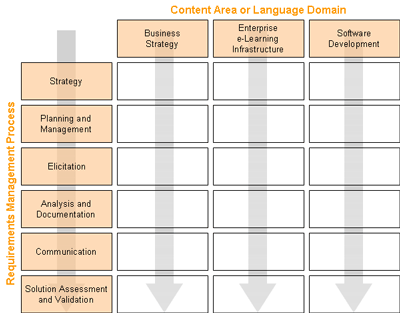

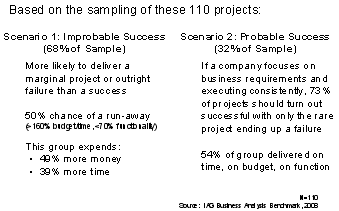
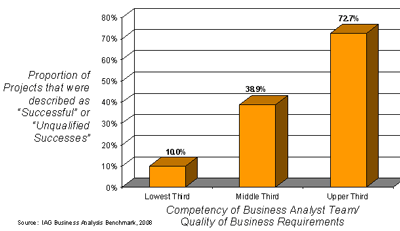 Companies with poor business analysis capability will have three times as many project failures as successes.
Companies with poor business analysis capability will have three times as many project failures as successes. 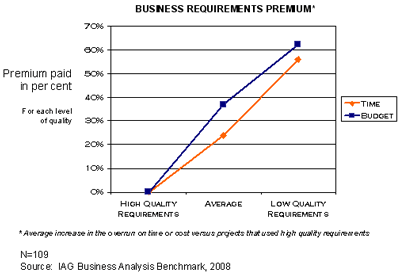 Companies pay a premium of as much as 60% on time and budget when they use poor requirements practices on their projects.
Companies pay a premium of as much as 60% on time and budget when they use poor requirements practices on their projects. 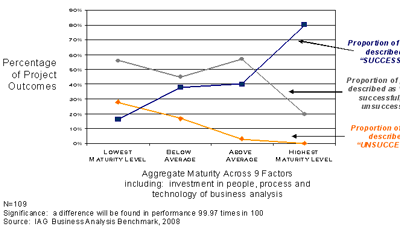 80% of projects where successful from companies with mature requirements process, technology and competencies.
80% of projects where successful from companies with mature requirements process, technology and competencies. 
 We’re just into our second month of this Leap Year with our “once in four one day more” 29 day February and already we’re up to our necks in activity, getting each Business Analyst Times online, planning for the next one and organizing a year’s worth of Business Analyst Worlds.
We’re just into our second month of this Leap Year with our “once in four one day more” 29 day February and already we’re up to our necks in activity, getting each Business Analyst Times online, planning for the next one and organizing a year’s worth of Business Analyst Worlds.